It is easy to build an e-commerce website. But a website that actually converts and generates lots of sales? That’s a very different beast.
If you have ever asked yourself why you are not achieving your sales goals even though your website is bringing in a lot of traffic, you are probably missing important conversion-related elements on your website.
The big problem is that most people think that getting new customers only has to do with increasing traffic through paid advertising. Ready for the truth? Sending traffic to a site that does not convert makes that traffic much less relevant.
This is why it is so important to first increase your website conversion rate using conversion rate optimisation.

Lucky for you, we can already help you with some tips. In this blog, we discuss why Conversion Rate Optimisation (CRO) is important and how you can improve it with some quick wins.
If you would like to convert your traffic into leads and generate more sales, your website needs to be fully optimised.
Each page should have a specific purpose. Your content, texts, CTAs and navigation should help you achieve this goal.
The point is that visitors’ goals may be different from yours. To get them to take the desired action, you need to appeal to their interests.
This means understanding their behaviour and tailoring the website to the factors that make your visitors convert. That process is called Conversion Rate Optimisation.
Conversion Rate Optimisation (CRO) is the process of improving your site based on real data from your visitors. This includes things like data and competitive analysis, A/B testing and user research.
Ultimately, CRO helps you increase your conversions and make your website more profitable.
You can have the best resources, implement the best strategies and target the right audience, but your traffic is worthless if your site is not optimised for conversion.
Most people think that design is key for a revenue-generating website. The truth is that we have seen sites with mediocre designs yielding as many, if not more, conversions.
CRO is so important because it can turn an average campaign into a profitable one.
There are countless ways to improve your Conversion Rate. However, we will not go into the technical aspects of CRO. Instead, we are going to talk about the basics, the fundamentals you need to have a website that actually converts.
Not knowing who your avatar is (also known as your ideal customer) can break your business. If you don’t know who you are selling your stuff to, how can you expect to make sales?That is why it is important to start by creating your avatar first.
Once you have mastered your avatar, now what?
If you want to improve the conversion rate of your website, your text should speak directly to your avatar. That means not just showing the products you think they need. It means getting inside your customers’ heads and understanding their pain points. Then adapt your text to reflect the “conversations in their heads”. Your headlines, subheads, offers and CTAs should be targeted to the wants and needs of your avatars. This will help your visitors get clarity on your offer and positively influence their buying decision.
People don’t buy from someone they don’t even know. You have to gain their trust first. For that, you need to build a relationship with them. So how do you start?
By mapping your customer journey.
This is the path your visitors take before they become buyers and advocates of your brand. It is every interaction your visitors have – from the moment they hear about your brand until they buy your products. In other words, mapping your customer journey will help you change your customers from “Who are you?” to “I told my friends about your product and they bought it!”. Once the journey is set up, you will easily know what to put on your site, what your site navigation should look like, what offers you have and the corresponding CTAs.
Tip: Install a tool likeMicrosoft Clarity on your website to track and map the behaviour of website visitors in combination withGoogle Analytics 4.

Most people think of funnels as a “squize page” – a page designed to achieve just one goal: capture your visitor’s contact details.
This is why many people think they have no funnels.
The truth is, if you are a business, you have a funnel. There is no other option. A funnel is simply the steps someone takes with your business. If you don’t have control over your marketing funnel, you are leaving a lot of money on the table. Think of your funnel as a puzzle.
Each piece of the puzzle is your “customer touch point”. And the goal is to ensure that each piece of the puzzle (customer touchpoint) fits into the next and completes the puzzle (your business objectives). Therefore, optimising and controlling the funnel is crucial if you want to grow your business. Otherwise, you just leave things to chance. For example, one of the biggest misconceptions is that your funnel ends at the sale.
“What we see in many companies we work with is that they don’t have canned responses for the sales team. They just let the sales team write what they want, depending on how they feel that day. So they don’t control and optimise that contact moment.”
There are plenty of other things you can optimise.
The problem with traditional funnels is that while they work, they do not cover the entire customer experience. They only address how to move a customer forward. But how people decide what to buy lies in the “messy middle” of the buying journey.
You can control what’s on your website – the texts, navigation and CTAs… But if someone searches for your brand or product name and finds a bad review on a forum like Reddit, you are probably doomed.
All those CRO tweaks will have done nothing to convert that visitor. There are things your funnel just can’t control. The good news is that there is a way to avoid such things.
Brand reputation management, the process of monitoring and influencing how your brand is perceived online, can help catch those bad reviews.
Indeed, you can gather insights directly from your audience by listening to conversations about your brand or product via social media.
Then use that information to enhance your marketing message or create authoritative content that is not only educational, but also builds a community around your niche.
Branding is more important than ever.
Approaching CRO not only from a technical perspective, but also from a brand positioning strategy, will definitely help increase your conversions.
The more you optimise your brand, the more people become aware of your products, and the more customers you convert.

Co-Founder & CCO | Lead On Performance Marketing
Digital Marketing Consultant building a bridge between digital & data
That way, you’ll always stay on top of the latest digital trends and developments, and then be able to use them yourself!
Oudenaardsesteenweg 256 box 5
9420 Erpe-Mere
Monday - Friday.
8 AM - 6 PM
Copyright 2024 Lead On – BTW BE 0771.335.288 – Privacy – Terms and conditions